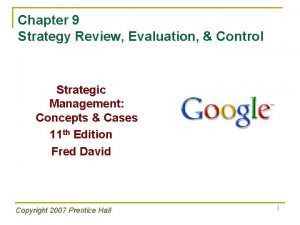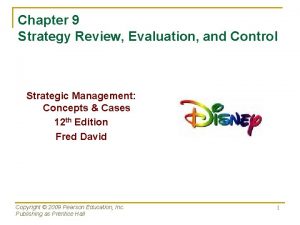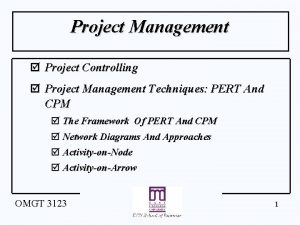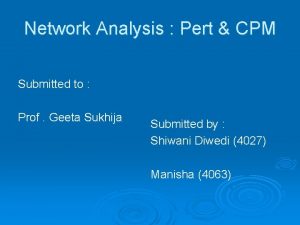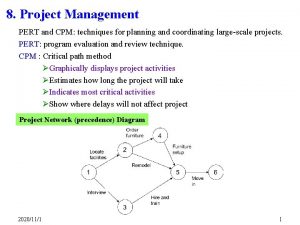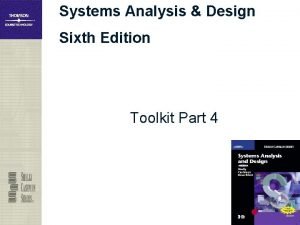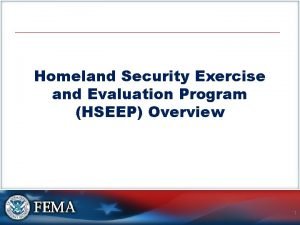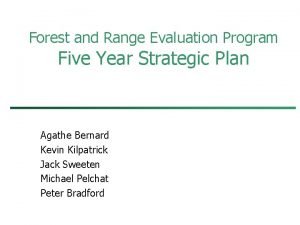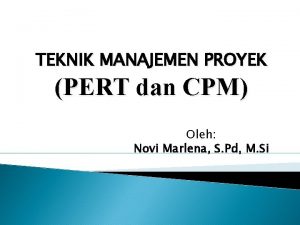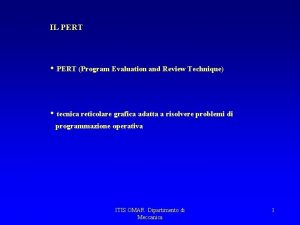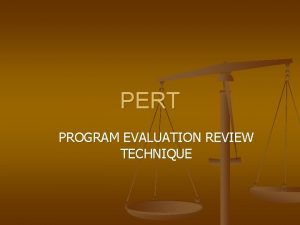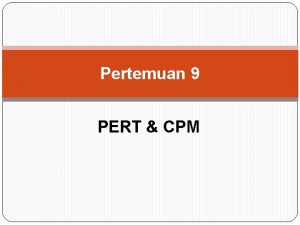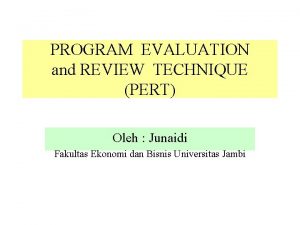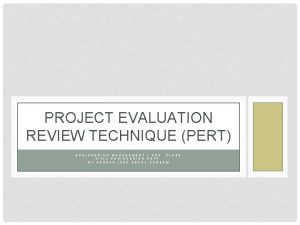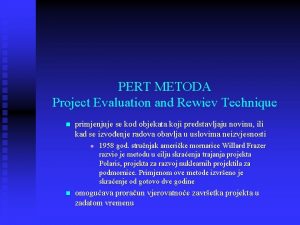Lecture 4 Program Evaluation and Review Technique PERT















- Slides: 15

Lecture 4: Program Evaluation and Review Technique (PERT) © J. Christopher Beck 2008 1

Outline n n Quick CPM Review Program Evaluation and Review Technique (PERT) © J. Christopher Beck 2008 2

Readings n n P Ch 4. 2, 4. 3 Slides borrowed from Twente & Iowa n See Pinedo CD © J. Christopher Beck 2008 3

A Small Example (again) “job on node”-representation: 1 2 3 © J. Christopher Beck 2008 4 6 5 4

Forward Procedure STEP 1: For each job that has no predecessors: STEP 2: compute for each job j: STEP 3: C’ 1 = 2 S’ 1 = 0 S’ 6 = 7 1 C’ 2 = 3 S’ 4 = 3 C’ 4 = 7 2 4 S’ 2 = 0 6 C’ 3 = 1 © J. Christopher Beck 2008 S’ 3 = 0 3 S’ 5 = 3 5 C’ 6 = 8 C’ 5 = 5 Cmax = 8 5

Backward Procedure STEP 1: For each job that has no successors: STEP 2: compute for each job j: STEP 3: Verify that: C’’ 1 = 3 S’’ 1 = 1 S’’ 6 = 7 1 C’’ 2 = 3 S’’ 2 = 0 S’’ 4 = 3 C’’ 4 = 7 2 4 6 C’’ 3 = 8 © J. Christopher Beck 2008 S’’ 3 = 7 3 S’’ 5 = 6 5 C’’ 6 = 8 C’’ 5 = 8 Cmax = 8 6

OK so … © J. Christopher Beck 2008 7

Uncertain Processing Times n n Great, project scheduling is easy! In the real world, do we really know the duration of a job? What if we have estimates of duration? What if we have a distribution: n pj = (μj, δj)? © J. Christopher Beck 2008 8

Program Evaluation & Review Technique (PERT) n Idea: estimate pj and use CPM to estimate: n n Ê(Cmax) – expected makespan Ṽ(Cmax) – variance of makespan © J. Christopher Beck 2008 9

Simplest Approach n n n Given pj = (μj , δj), let pj = μj Use CPM to find critical path Estimate the expected makespan n This is a very crude approximation! n n Ê(Cmax) = Σ μj, j in critical path Ṽ(Cmax) = Σ (δj 2), j in critical path See Example 4. 3. 2 Q: What if there are two CPs? © J. Christopher Beck 2008 10

Estimating (μj , δj) n Assume you have 3 estimates of pj n n Optimistic: paj Most likely: pmj Pessimistic: pbj Reasonable estimates: n n μj = (paj+4 pmj+pbj) / 6 δj = (pbj-paj) / 6 © J. Christopher Beck 2008 “No battle plan survives the first encounter with the enemy. ” 11

PERT Steps n 1. Find μj , δj 2 n n 2. Use CPM to find critical path(s) n n i. e. , using estimates on previous slide with pj = μj 3. Estimated expected value and variance of Cmax n Assume makespan is normally distributed © J. Christopher Beck 2008 12

PERT Problems n More than one CP? n non-CP with high variance? expected makespan must be larger than single CP estimate (why? ) Assumption of normal distribution © J. Christopher Beck 2008 13

PERT Practice n n Draw precedence graph Find μj , δj 2 Find Critical Path(s) Estimate expected value and variance of Cmax © J. Christopher Beck 2008 Job paj pmj pbj Predecessors 1 2 4 12 - 2 10 15 20 1 3 6 8 22 1 4 8 16 18 1 5 2 10 18 2, 3, 4 6 8 12 24 2 7 2 5 8 3 4 11 5 9 4 8 24 6, 7 10 1 5 9 8 14

More PERT Practice Example 4. 3. 1 Jobs 1 2 3 4 5 6 7 8 9 10 11 12 13 14 paj 4 4 8 10 6 12 4 5 10 7 6 6 7 2 p mj 5 6 8 11 7 12 11 6 10 8 7 5 p bj 6 8 14 18 8 12 12 7 10 15 8 10 7 8 Hint: same graph as 1 4. 2. 3 2 3 © J. Christopher Beck 2008 4 6 7 9 10 11 5 8 Find expected makespan and variance 12 14 13 15
 01:640:244 lecture notes - lecture 15: plat, idah, farad
01:640:244 lecture notes - lecture 15: plat, idah, farad Fedex balanced scorecard
Fedex balanced scorecard Strategy review evaluation and control
Strategy review evaluation and control What is cpm in project management
What is cpm in project management 3+6×(5+4)÷3-7
3+6×(5+4)÷3-7 Cpm
Cpm Pert and cpm
Pert and cpm Gantt and pert charts
Gantt and pert charts Hrd program implementation and evaluation
Hrd program implementation and evaluation Homeland security exercise and evaluation program
Homeland security exercise and evaluation program Forest and range evaluation program
Forest and range evaluation program Metode cpm
Metode cpm Pert equation
Pert equation Pert formula
Pert formula Pert stands for
Pert stands for Gantt vs pert
Gantt vs pert

